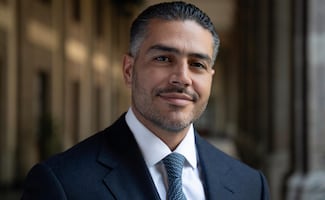Más Información

New York Times destaca rol de Harfuch en el combate del narco; resalta intercambio de inteligencia con EU

Marco Rubio destaca labor de seguridad de México; "están haciendo más que nunca en su historia", afirma

"Queremos cerrar este capítulo", dice Salinas Pliego al SAT; esperarán a enero a conocer fundamentos legales de adeudo fiscal
The new plan dictated by the White House to tackle the increasing flow of migrants coming from Central America is doomed to fail, according to Falko Ernst , an analyst from the International Crisis Group in Brussels .
In an interview with EL UNIVERSAL , the expert commented that prioritizing border militarization instead of tackling the root causes of the problem would only worsen the crisis.
Ernst added that the deployment of the National Guard would not stop migrants from coming to Mexico since not even the United States, with its unparalleled military resources, has been able to fully protect its southern border from illegal immigrants.
“The deployment of federal forces will likely increase the number of arrests and deportations, but given the critical situation of Central America , most migrants won’t be dissuaded and will continue to try and make their way into the United States,” the expert assured.
The migrants’ journey through Mexico has always posed a series of risks due to the strong presence of criminal groups and the corruption of authorities. However, there will still be migrants willing to endure those hardships in the future.
“The deployment of the National Guard will not put an end to the flow of migrants traveling to the U.S. border , as Trump has suggested,” he insisted. “In fact, the United States has not been able to stop them, even though they have militarized their southern border since the 1990s.”
According to Silvia Garduño , from the United Nations Agency for the Refugees (UNHCR) , people in Central America usually leave their home countries due to a number of reasons, including unemployment, the strong impact of climate change in the farming sector, which has in turn increased food insecurity, and extreme violence.
A cyclical phenomenon
The Coordination Center for Emergency Response from the European Union reported that out of all 400 thousand migrants from Guatemala, Honduras, and El Salvador who entered Mexico illegally in 2018, around 50% came from rural regions . In the case of Guatemalans, the number rose to 80%. On the other hand, around 60% of Salvadorans were unaccompanied minors.
Out of the total of migrants deported from the Mexican territory, only 15% returned to urban areas, indicating that the Central American region is undergoing a cyclical phenomenon exacerbated by prolonged droughts, lack of food, and declining resources. The deportation of Central Americans from the United States has also caused a decrease in the flow of remittances, which is a primary source of livelihood for the farming sector.
The European Commission claims that the conditions causing the migration crisis still persist, with 20.3 million people living in the so-called “Dry” Central American Corridor , out of which 3.15 million are undergoing a food crisis, and 757 thousand are living in a state of emergency. “Added to this is the perception of opportunities in other countries, which is promoted by human trafficking networks. However, most migrants are fleeing from violence and persecution,” Garduño explained.
The Network of Environmental Funds of Latin America and the Caribbean , which is supported by the French government, has claimed that in communities most affected by criminal violence, going to school is extremely dangerous for children and adolescents since the maras have infiltrated education centers. “The children are victim of extortion and are sometimes recruited by the maras at school. The criminal groups end up controlling and haunting the lives of children, adolescents, and even some teachers,” they indicated.
“The government’s response has been null due to a lack of resources and public policies. Moreover, Central American governments have failed to provide victim protection services,” reads the report conducted in cooperation with the Norwegian Refugee Council.
Falko Ernst predicts that a further militarization of the anti-immigration policy promoted by the United States would increase humanitarian costs for migrants, specially those who have become stranded in the Mexican territory, where they are exposed to criminal groups, extortion, kidnapping, and criminal recruitment.
He considered that a larger exposure of migrants to illegal activities and an increase in fees from ‘coyotes’ “could imply a higher risk of organized crime growing stronger in Mexico.”
A diversion of resources
On the other hand, the use of the National Guard in tasks beyond its original purpose would entail a diversion of resources and manpower that will jeopardize the government administration’s commitment to improving public security in the rest of the territory.
According to the expert, the right answer would have been for Mexico to create a civil force with economic, technical, and logistic resources to manage migration in a professional way respectful of human rights.
However, with the commitment agreed on with the U.S. government , Mexico has fallen into a trap that serves the interests of President Donald Trump , who will seek reelection in 2020.
“Mexico has very few options due to its heavy economic dependence on the United States. On the other hand, by attacking Mexico constantly, Trump has found a perfect tool to secure a second term in the White House,” Ernst claimed.
“Mexico should make it clear that the cooperation between both nations is more important than U.S. national security, and that Trump’s threats are counterproductive,” he added.
The expert added that Mexico should work to expand its migration mechanisms so that asylum seekers in need of protection can access the national territory in an organized and effective way.
dm
Noticias según tus intereses
[Publicidad]
[Publicidad]












